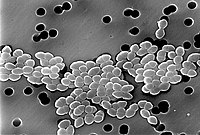
Photo from wikipedia
OBJECTIVES To evaluate the transferability of antibiotic resistance from an MDR clade B Enterococcus faecium and to characterize the genetic elements involved. METHODS The erm(B)-positive strain E. faecium 37BA (donor)… Click to show full abstract
OBJECTIVES To evaluate the transferability of antibiotic resistance from an MDR clade B Enterococcus faecium and to characterize the genetic elements involved. METHODS The erm(B)-positive strain E. faecium 37BA (donor) and strains E. faecium 64/3 and Listeria welshimeri 11857RF (recipients) were used in mating experiments. Donors and transconjugants were characterized using MIC assays, PFGE, Southern blotting and hybridization, quantitative RT-PCR (RT-qPCR), next-generation sequencing and PCR mapping. RESULTS One E. faecium and one L. welshimeri transconjugant were selected for in-depth investigation. Both acquired an ∼40 kb plasmid carrying erm(B). An additional plasmid of ∼200 kb, encoding the full conjugation machinery, was detected in the donor and in the E. faecium transconjugant. Next-generation sequencing revealed a new 40 396 bp plasmid that was designated pEf37BA; it contained 10 antibiotic resistance genes, tet(M), tet(L), erm(B), aadE, sat4, aphA, spw, lsa(E), lnu(B) and pbp5, resulting from the recombination of pM7M2 of E. faecium with an MDR chromosomal region of Erysipelothrix rhusiopathiae. A pbp5-carrying circular form was also detected. The PBP5 amino acid sequence differed from the C46 variant by two mutations (S39T and D644N). Its expression was documented in both transconjugants. pEf37BA persisted in the absence of selective pressure. CONCLUSIONS The MDR clade B E. faecium plasmid, deriving from the recombination of two different resistance regions, carried a pbp5 element and was transferable to different bacterial species. This finding further documents the dissemination of ampicillin resistance among community-associated E. faecium and the key role of commensal strains in the spread of antibiotic resistance.
Journal Title: Journal of Antimicrobial Chemotherapy
Year Published: 2019
Link to full text (if available)
Share on Social Media: Sign Up to like & get
recommendations!